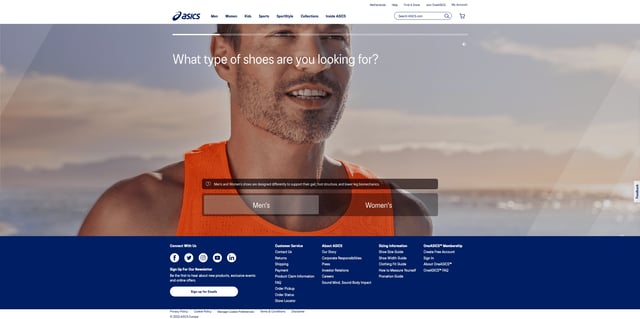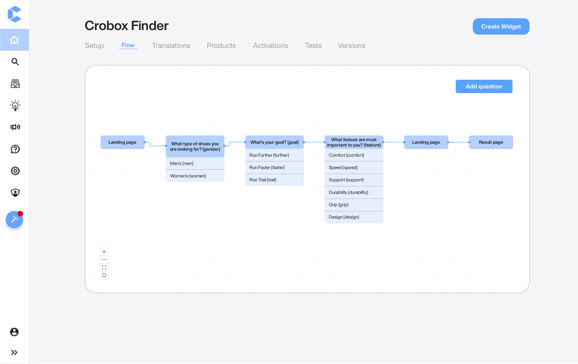Whether you call them eCommerce product finders, product advisors, or recommendation quizzes, it’s virtually all the same. Learn how to design and build one.
Imagine for a moment, you’re looking to buy a new coffee machine. Typically, you enter a store, followed by a shop assistant greeting you: “Hi, how can I help you?”
But you’re not sure what you’re looking for. Plus, there are just so many machines you could choose from. The sales assistant says, “I’m here to help. What kind of coffee do you drink?”
Then, they ask you a series of questions to assess your needs, desires, and lifestyle. With this information, they guide you to the best coffee machine. You’re matched with the best product – perfect for your coffee of choice, with just the right functionalities for you and your family, and one that is recommended by the expert (sales assistant).
It’s so perfect you never have to return it – every morning you wake up to the smell of perfectly brewed coffee. Now, imagine this experience online. eCommerce product finders are basically in-stores sales assistants. They ask a series of questions to recommend products to the customer and guide the sale in a natural way.
What are eCommerce product finders?

eCommerce product finders are quiz wizards that ask your website shoppers questions to identify their needs and wants. Based on the answers, the finder recommends the perfect product(s). eCommerce product finders create a dialogue with your customers to facilitate better decisions throughout their customer journeys and as they navigate your webshop funnel.
Online, the product-finding process boosts conversions – a secondary goal. But product finders also lower returns, ultimately creating a guided selling experience that is interactive, informative, and human. Product finders don’t simply copy the in-store sales assistant online, they also take it one step ahead, elevating the discovery experience through:
- Personalization
- Conversational intelligence
- Data analysis
This article aims to be a springboard to your eCommerce product finder learning. Let’s go.
What’s the difference between a product finder and a product quiz?
Product quizzes often have a set of rules they generate answers from (like a decision tree). They have hard-coded recommendations with static answers.
Product Finders, conversely, are often rule-based or use machine learning algorithms to recommend one perfect product (rather than a product page, style, or multiple products). The difference is that the answers are smart, and can be dynamic.
Both are great guided selling tools that drive decision-making on your webshop. And if driving decision-making isn’t enough of a reason, there are plenty more reasons why you should start with product finders today.
Why should you implement eCommerce product finders today?
1. Your customers are drowning in choice
.png?width=512&height=276&name=customer-choice-paralysis%20(1).png)
Source
Choice overload is very real. It’s the feeling you get when you’re trying to think of what to cook. Or what Netflix show to put on. Or whether to have that final drink.
Ultimately, choice overload causes hesitation, frustration, and, in more extreme cases, anxiety. In retail, choices saturate the market. We’ve never had so many running shoes, cosmetics, and electronics brands as we do today.
How do you make your products stand out? Product finders help narrow down choices for your customers. They act as a filter to match a customer with the perfect product for them. This works by:
- Pointing out products that matter
- Giving tailored recommendations
- Showing personalized information to increase buyer confidence
2. Shoppers miss the human touch online
.png?width=512&height=357&name=human-touch-online%20(1).png)
Source
According to MarketingTech,
- 66% of shoppers miss the ability to try on products online
- 64% miss touching and feeling products
- 17% say online shopping lacks the advice of sales assistants
With more people shopping online than ever before, it’s clear there’s something missing in the eCommerce experience. Customers still want a tactile and interactive product discovery process. Product finders let customers interact with the products, and bring human conversation into the online environment.
Consumer purchasing decisions are formed by emotions (according to neuroscientist Antonio Damasio). If you can create an empathetic buying experience at crucial touchpoints in the customer’s journey, you can bring the human online. With product finders, you listen to your customers and offer them relevant products based on their answers.
3. Reducing returns is a top business priority
.png?width=512&height=288&name=returned-purchases%20(1).png)
Source
Forbes estimates that 30% of all purchases are returned. The increase in impulse buying during the pandemic also indicates how retailers need to provide better product information to keep return these rates under control.
In fact, 60-65% of returns are linked to product information quality and decision-making. So the best way to reduce returns? Provide clear product information at crucial moments and products that fit in line with the customer’s context.
In this way, product finders reduce returns because they provide:
- A unique product recommendation (based on the customer’s answers)
- Condensed product information (usually from the product detail page (PDP))
- The opportunity for customers to learn more about a product
For example, coupling your product finders with a product comparison tool is a great way to take your product discovery one step further.
4. Customer data is becoming more and more protected
Online shoppers are increasingly becoming aware of the implications of data breaches. With the growing importance of privacy, they are much more aware of the purchasing decisions they make.
Customers today expect two things when shopping online:
- Data privacy and security
- Personalized customer experiences
Product finders address both of these things, future-proofing your webshop for a cookie-less future.
That’s because product finders collect customer-approved data (i.e., zero-party data) by asking questions to the customer directly, and then recommending the perfect product based on their answers.
It’s a win-win for the brand and the customer.
The benefits of using an eCommerce product finder
 Source
Source
In short, product finders are great to:
- Simplify complex products
- Show your product attributes in a way that resonates
- Match shoppers to the products that they seek
- Guide shoppers to the product detail page (PDP)
- Encourage purchase behavior
- Build brand authority and expertise
- Understand your customer’s psychographics
- Enable category or product line recommendations for future re-targeting
- Guide shoppers through the webshop funnel so they can navigate your website better
Product finders, in essence, also assist in nudging customers along your check-out journey, and directly contribute to greater conversions.
Turning product finder data into actionable insights

Implementing a product finder on your eCommerce platform is great.
But guess what? Your product finder strategy doesn’t stop there. In effect, without collecting data from your product finders you won’t be able to:
- Continuously optimize the flow
- Up and cross-sell your products and/or collection
- Learn what your customers love about your products
- Optimize your marketing campaigns
Data can be daunting. Yet, without it, your eCommerce store won’t be able to anticipate the market better.
At Crobox we offer a product finder dashboard that is both editable and customizable, so you can centralize the data from your guided selling tool in one place.
Get in touch to see it in action.
